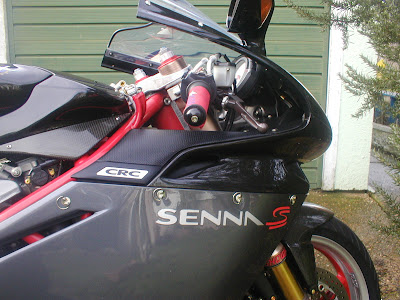Thirty years ago I would have been using cellulose paint. Today its becoming increasingly difficult to get a top coat cellulose and even then it depends on the make up of the paint i.e straight colours as opposed to metallics.
When I started out it was not uncommon for my local paint supplier to give me tinted cellulose clears in order to replicate the then new japanese candy motorcycle colours, today it's "got to be" an acrylic product and often a three stage paint system otherwise known as two pac. So whats it all about.
I was watching a documentary about the culture of coach travel in the UK and there was lots of footage showing coaches from the fifties, obviously I was drawn to the old vehicles and one clip showed a guy hand painting a coach. The finished job looked stunning, no spray gun, just a brush, a tin of coach enamel and a lot of know how.
The coach painter and the traditional oil based coach enamel paint became obsolete over time and with it the loss of a particular skill base. You can still buy synthetic enamels that can be applied by brush or gun but over time the coach painter was replaced by the spray painter and enamels applied by gun were usually confined to big commercial vehicles. The automotive world was ruled by cellulose. A new skill base was called for, cellulose comes out the gun 'dry' so you needed an understanding of the paint and skill to work towards a 'wet finish'. and then a polish to bring up that deep lustre finish. Drying times were drastically shorter then using enamels, mistakes could be rectified quickly making cellulose commercially more viable, more cost effective. Commercial vehicles were usually finished by gun with air drying synthetic enamels and this paint allowed the painters the flexibility to touch in chassis misses by hand with a brush.
As with the traditional oil based enamels the finishing top coat was the colour. With enamel you worked towards a high gloss brush finish minus the brush marks. This was achieved through understanding the viscosity of the paint and its run out nature, but the finish was gloss much like the paint you would paint your front door with.
With cellulose you built up your colour layers, flattening off between coats, finishing with a wet top coat but usually needing to polish the cellulose up into the high lustre gloss finish.
Today cellulose is becoming harder to get and acrylic clear over base paint systems are the norm. In later blogs I will talk about the confusion between fact and fiction in relation to what is 'best' for the end user, thats you. And remember when I talk about the end user I'm not talking about motorists I'm talking about motorcyclists.
Clear over base is as it says on the tin a coloured base that dries to a matt finish and a clear lacquer to finish. The clear can be a single pac acrylic or a two pac. The two pac contains isocyanates and must be used in a strictly controlled environment.
I purchased this MVagusta limited edition Senna in 2002 the panel you are looking at was subsequently repaired by me in 2004 using two pac after a spill. What I became very aware of was that although the Senna looked stunning in its deep lustre finish if you carefully looked 'through' the lacquer to the base coat you could see a multitude of surface imperfections that were hidden unless looked for. The beauty of acrylic lacquers, they can cover up a lot of sloppiness, so beware.
In later blogs I will share with you my take on automotive paint development and how this impacts on you the classic motorcycle restorer.

No comments:
Post a Comment